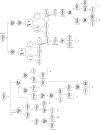Clinical and molecular cytogenetic findings and pregnancy outcomes of fetuses with isochromosome Y
- PMID: 35927742
- PMCID: PMC9351221
- DOI: 10.1186/s13039-022-00611-3
Clinical and molecular cytogenetic findings and pregnancy outcomes of fetuses with isochromosome Y
Abstract
Background: The mosaic forms and clinical phenotypes of fetuses with isochromosome Y are difficult to predict. Therefore, we summarized the cases of nine fetuses with isochromosome Y identified in prenatal diagnosis with a combination of molecular cytogenetic techniques, providing clinical evidence for prenatal genetic counseling.
Methods: The prenatal diagnosis and pregnancy outcomes of nine fetuses with isochromosome Y were obtained by a retrospective analysis. Isochromosome Y was identified prenatally by different approaches, such as conventional karyotyping, chromosomal microarray analysis (CMA), quantitative fluorescent polymerase chain reaction (QF-PCR) and fluorescence in situ hybridization (FISH).
Results: Seven idic(Y) fetuses and two i(Y) fetuses were identified. One fetus was complete for i(Y)(p10), and the rest with 45,X had mosaic forms. A break and fusion locus was identified in Yp11.3 in one fetus, in Yq11.22 in six fetuses and in Yp10 in two fetuses. The CMA results suggested that different deletions and duplications were found on the Y chromosome. The deletion fragments ranged from 4.7 Mb to the entire Y chromosome, and the duplication fragments ranged from 10.4 to 18.0 Mb. QF-PCR analysis suggested that the AZF region was intact in one fetus, four fetuses had AZFb+c+d deletion, one fetus had AZFa+b+c+d deletion, and one fetus had AZFc+d deletion. Finally, four healthy male neonates were delivered successfully, but the parents of the remaining five fetuses, including three healthy and two unhealthy fetuses, chose to terminate their pregnancies.
Conclusion: The fetus and neonate phenotype of prenatally detected isochromosome Y usually is that of a normally developed male, ascertained in the absence of other indicators of a fetal structural anomaly. Our study provides clinical reference materials for risk assessment and permits better prenatally counseling and preparation of parents facing the birth of isochromosome Y fetuses.
Keywords: CMA; FISH; I(Y); Idic(Y); Isochromosome Y; Mosaicism; Prenatal diagnose; QF-PCR.
© 2022. The Author(s).
Conflict of interest statement
The authors declare no competing interests.
Figures

Similar articles
-
[Prenatal diagnosis analysis of three cases of Turner syndrome fetuses with complex mosaic small supernumerary marker chromosomes].Zhonghua Yi Xue Yi Chuan Xue Za Zhi. 2024 Nov 10;41(11):1363-1370. doi: 10.3760/cma.j.cn511374-20231122-00268. Zhonghua Yi Xue Yi Chuan Xue Za Zhi. 2024. PMID: 39528288 Chinese.
-
[Molecular cytogenetic analysis and diagnosis of three fetuses with psu idic(Y)(q11.22) using a combination of multiple techniques].Zhonghua Yi Xue Yi Chuan Xue Za Zhi. 2025 Mar 10;42(3):360-367. doi: 10.3760/cma.j.cn511374-20241112-00585. Zhonghua Yi Xue Yi Chuan Xue Za Zhi. 2025. PMID: 40372230 Chinese.
-
Prenatal genetic analysis and differential pregnancy outcomes of two de novo cases showing mosaic isodicentric Y chromosome.Mol Cytogenet. 2020 Feb 11;13:7. doi: 10.1186/s13039-020-0472-y. eCollection 2020. Mol Cytogenet. 2020. PMID: 32071615 Free PMC article.
-
Mosaic isochromosome 20q at amniocentesis: Prenatal diagnosis, genetic counseling and literature review.Taiwan J Obstet Gynecol. 2019 Nov;58(6):855-858. doi: 10.1016/j.tjog.2019.08.002. Taiwan J Obstet Gynecol. 2019. PMID: 31759542 Review.
-
Phenotype/karyotype correlations of Y chromosome aneuploidy with emphasis on structural aberrations in postnatally diagnosed cases.Am J Med Genet. 1994 Nov 1;53(2):108-40. doi: 10.1002/ajmg.1320530204. Am J Med Genet. 1994. PMID: 7856637 Review.
References
-
- Mark HFL (ed). Medical cytogenetics. 1st edn. CRC Press; 2000. p. 728.
Grants and funding
LinkOut - more resources
Full Text Sources
Miscellaneous

